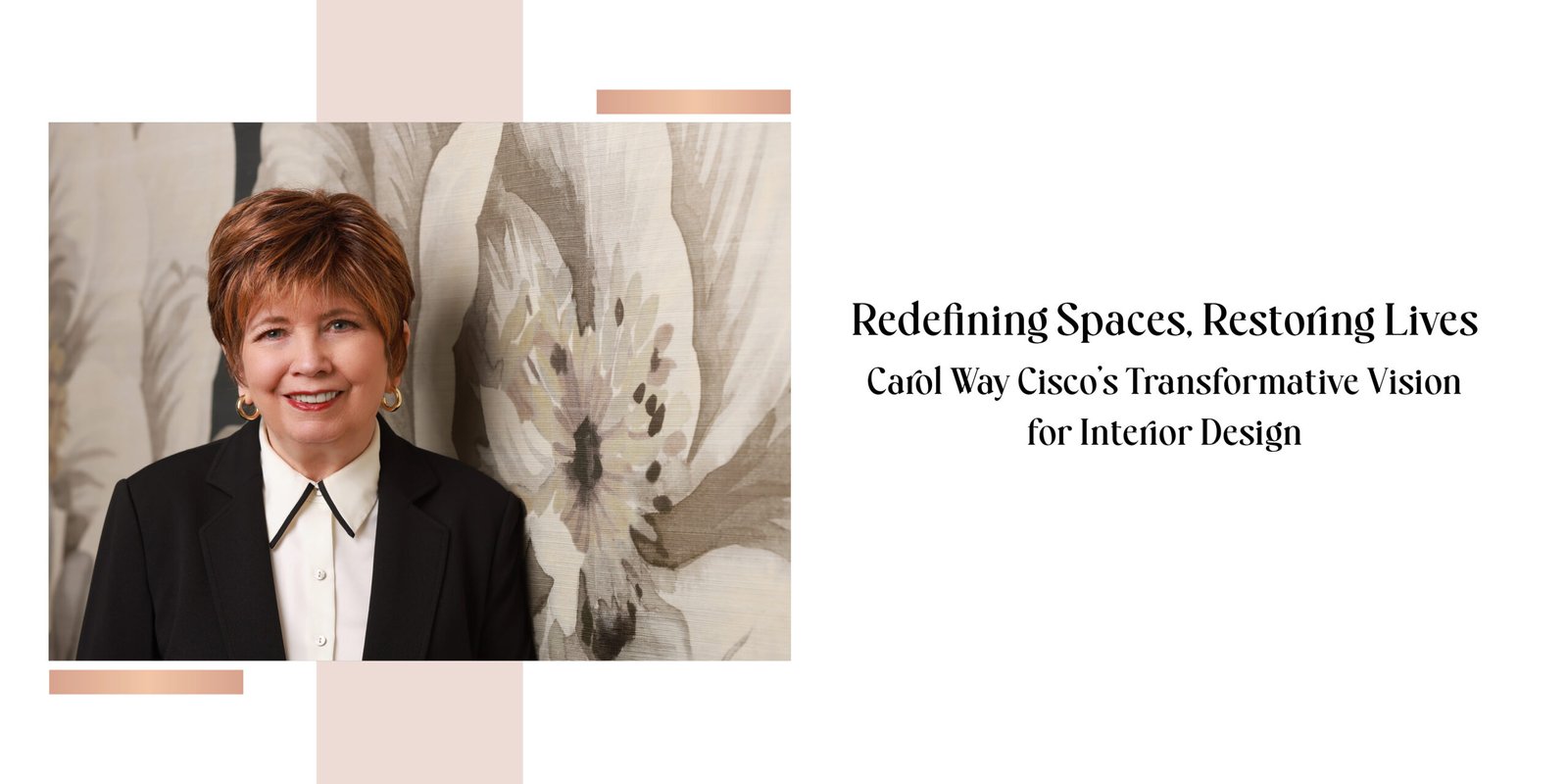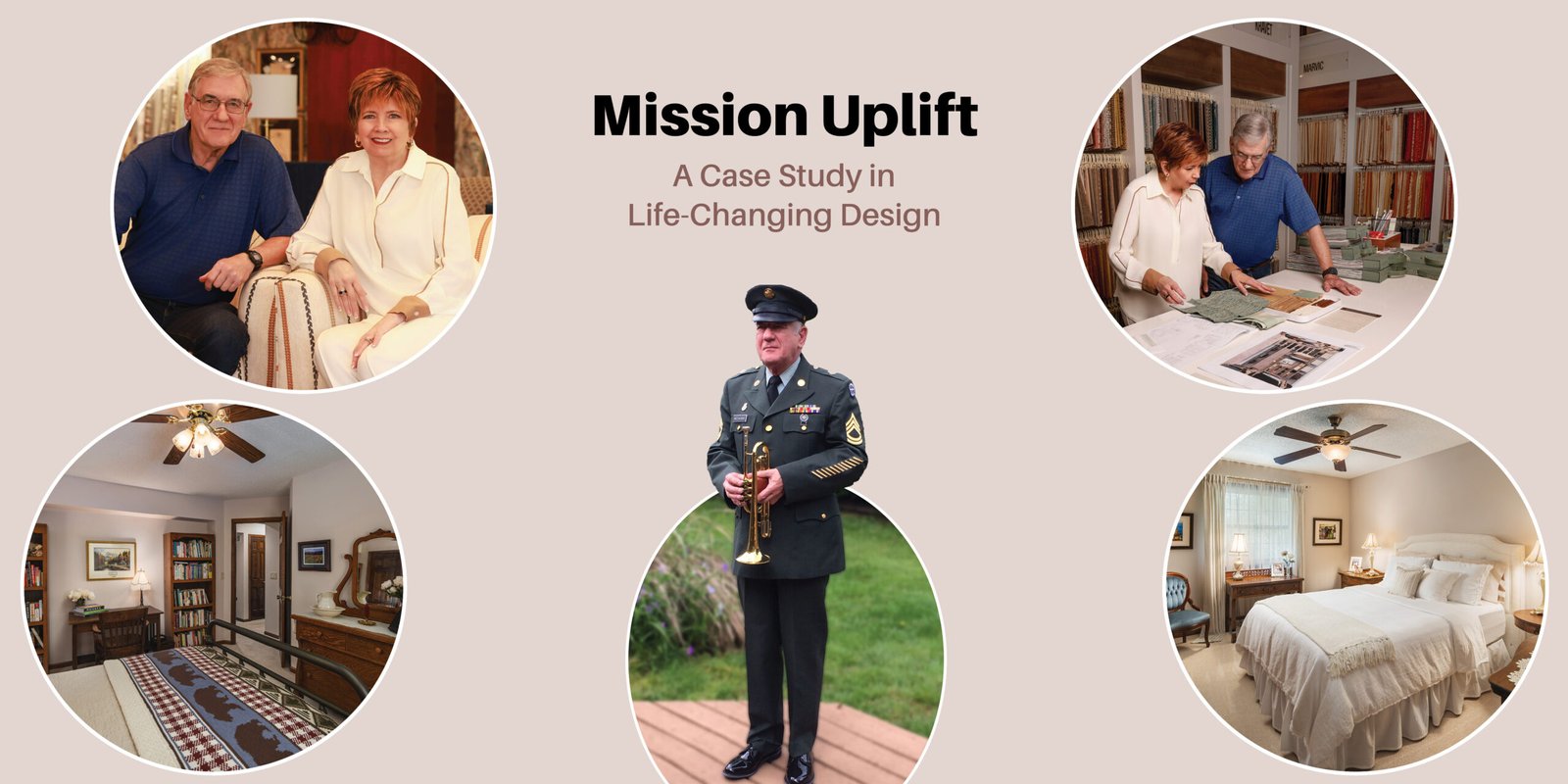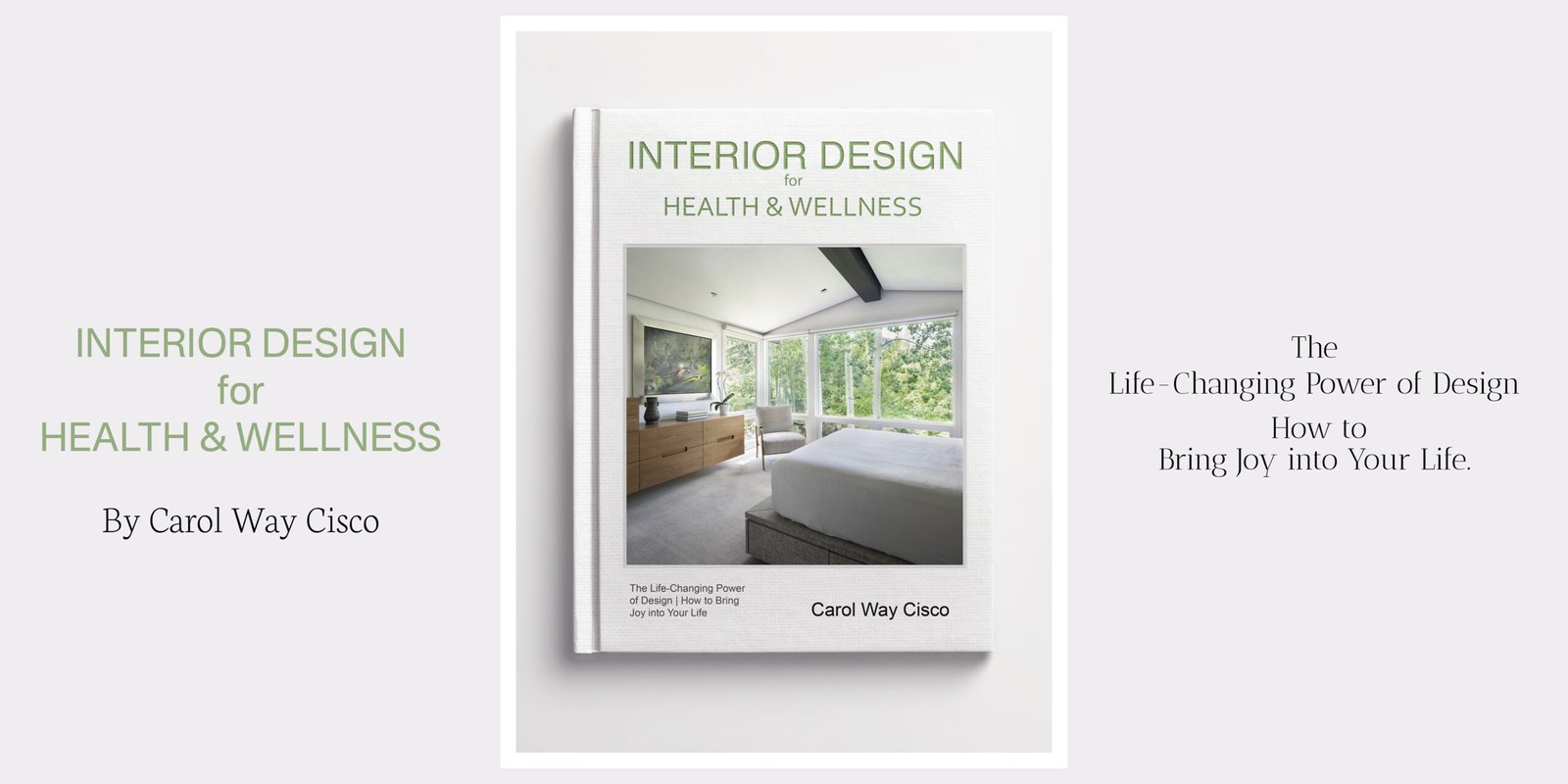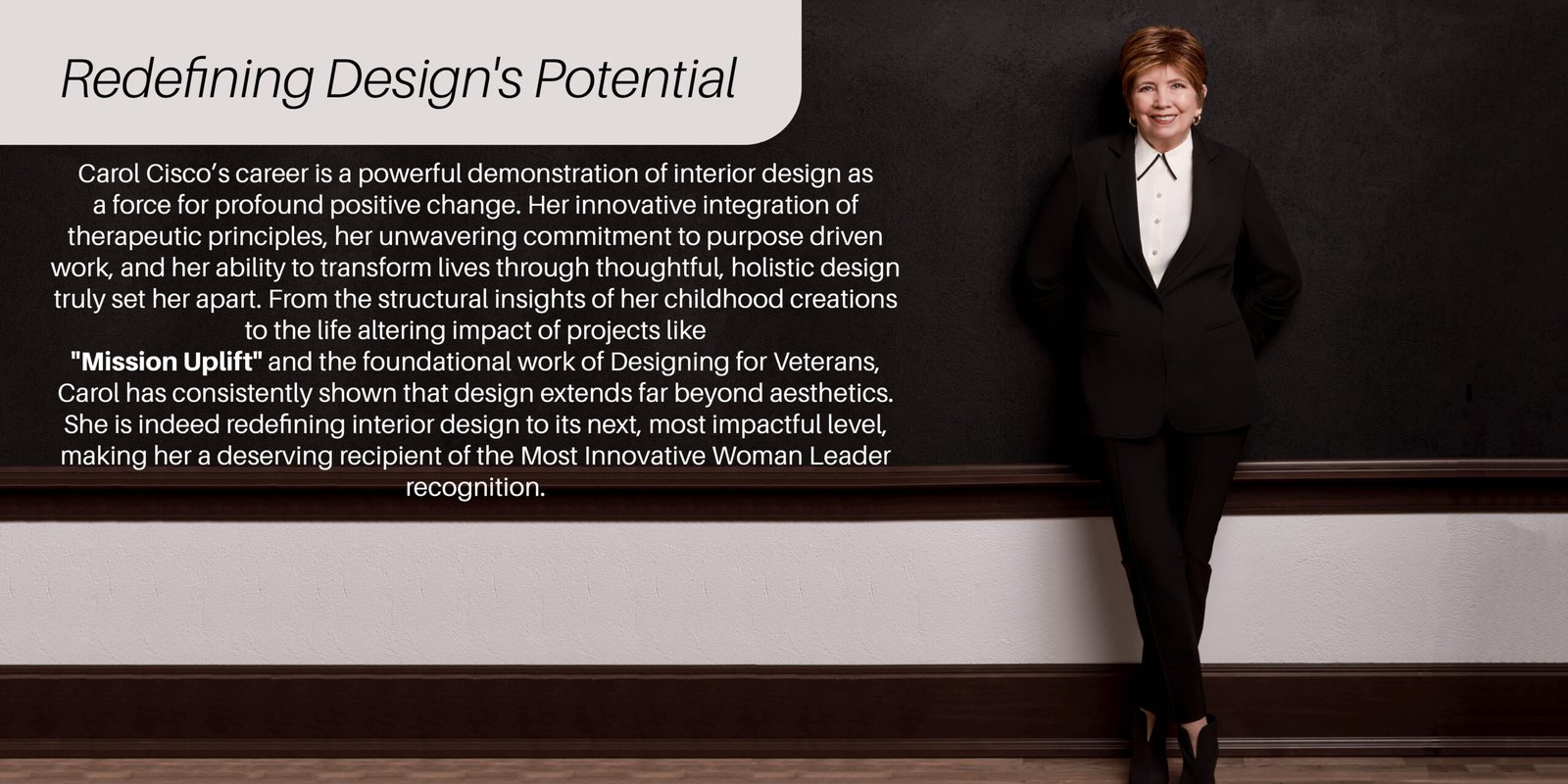Most Innovative Woman Leader Redefining Interior Design to Next Level

Healing Spaces: Carol Cisco’s Revolutionary Vision for Therapeutic Interior Design
By The Influential Today Magazine
The Influential Today Magazine is honored to feature Carol Way Cisco as a Most Innovative Woman Leader Redefining Interior Design to the Next Level. With a remarkable career spanning over four decades, Carol has consistently pushed the boundaries of interior design, imbuing spaces with not just aesthetic appeal but profound therapeutic purpose. Her work, ranging from luxury residences to large scale public facilities across the globe, reflects a deep understanding of how environments can shape human experience and wellbeing. In an insightful conversation, Carol shared the journey, philosophies, and transformative projects that define her innovative approach.

An Early Calling: The Foundations of a Design Visionary
Carol Cisco’s journey into the world of design began with a clear vision at a remarkably young age. “Very early, at the age of seven years, I wanted to be an architect,” she recalled. This was not a fleeting childhood fancy. “To fulfill that desire, without waiting to grow up, I built two story houses out of cardboard. They included fireplaces, windows, roof and siding; even structural elements to hold the house together. Then I handcrafted the interiors with rugs, drapes and furniture.” Her ambition extended beyond the structures themselves. “Placing these ‘houses’ outside our home allowed me to create the landscaping needed to complete my vision.”
A charming anecdote illustrates her innate grasp of design principles. “Taking grass seed from my father’s stash I planted it around my house and waited for it to grow. It wasn’t long before I realized there was a problem. I went storming into our house and angrily demanded my dad to get me smaller grass seeds! ‘Why?’, he said. ‘Because your grass seed is too big for my house!’, I exclaimed.” It was a moment of early revelation. “It wasn’t until years later that I recalled this story to a friend when I realized I understood scale, structure and design at the age of seven!”
Her learning process was hands on and observational. “I used the world around me to figure out how to not only design but construct. I continued to study my environments inside and out.” Nature became a significant influence. “Loving nature and travelling to national parks was a large influence in a holistic way. I found I felt better within the canyons and forests. This fostered my exploration as to whether nature was healing.” This curiosity sparked fundamental questions that would guide her career: “I was full of questions. ‘Can the interior environment do the same?’ I was always thinking and seeing my environment from outside the box.”
Purpose-Driven Design: Beyond Aesthetics to Healing Environments
Carol’s design philosophy quickly evolved beyond mere visual appeal. “Purpose is the driving force,” she stated. “From the very beginning of my career I was not happy just making environments look beautiful. While I was always pleased with the aesthetics as did my clients I felt empty. There has to be a greater purpose to what I do. It was important to me for my work to be meaningful.” This quest for meaning led her to impactful projects. “As a result when offered to design the international offices of several non-profit social betterment facilities I jumped at that opportunity. That began a twenty five year long career providing functional and beautiful facilities so that the non-profits could help others.” These included significant undertakings such as “the largest drug rehabilitation facility in the US. And a teaching college that teaches teachers an advanced technology of how to study so they could be better equipped to help their students thus helping both the student and teacher to succeed in life.”
The true depth of design’s impact on humankind became clearest through her own non-profit initiative. “It was when I started my own non-profit, Designing for Veterans, where I discovered the true impact of design on humankind. In that research and application I found something beautiful and functional can also serve another purpose; improving one’s health and wellness. It can be a place of healing.”
She provided a poignant example related to veterans. “The awareness and perception levels of our veterans is highly acute. Higher than the ordinary person. The slightest detail integrated into their home can cause a trigger for many. A painting over the fireplace with a beautiful ‘exploding’ sunset could trigger the trauma of a helicopter crash where his buddies were killed.” This understanding extended to all individuals. “I soon found many versions of this and learned it not only influences one’s mood but their health and ability to heal. Later I quickly discovered that this is true for all of us; not just veterans. A squeaky screen door that screams out every time you open it can be irritating. Dealing with that day after day will finally reach a point that is not tolerable on a subconscious level, and on a conscious level you blow up blaming the cause on something or someone other than what it is; a squeaky door.”
Importantly, she emphasized the positive corollary. “Details can bring happiness and joy into your life. While you avoid the triggers, designing with elements that bring joy into the built environment is the positive approach to healthy design. As a designer you must discover what makes the client and their family happy. Get rid of the items and details that don’t and only provide the details that do. There is an inherent aesthetic when you do.”

The Science of Sanctuary: Integrating Wellness into Every Space
Carol’s ability to integrate health, comfort, and psychological wellbeing into spaces is rooted in a diverse skill set. “Fortunately, I have training in the science of mental health in addition to my Interior Design BA, and accreditation in Wellness Design and Leadership in Energy and Environmental Design,” she explained. “Add to that decades of designing most anything you can think of I gained tools that complement my ‘outside the box point of view’ when analyzing environments. A perspective that not only sees things differently but senses (feels) the environment. This is ‘thinking outside the box’ at its best.”
The practical application of these elements is straightforward yet profound. “How to integrate these elements is actually simple. Keep toxic materials out of the design such as formaldehyde, or products that have volatile organic compounds to help provide healthy air quality.” Comfort, she noted, arises from a comprehensive understanding of design. “For example, colors creates moods that can cause depression or happiness. Shapes do the same thing.”
Lines, too, play a crucial role. “Lines have a large influence on human reaction and emotions. Take graphics in set design for movies, magazine design or poster design or most anything with lines. For years it has been known that you can create a downer in human emotion with ‘mood lines’. Lines in a piece of art or hanging pictures on a wall that trend downward can crash your emotions. However, lines in magazine graphics trending upwards can create the feeling of joy, happiness or exhilaration. Alfred Hitchcock was an expert in creating moods with lines and lighting.”
To tailor these elements effectively, Carol employs a specific client centered process. “The important aspect is how does a designer determine the elements that create sadness or joy. For that I have a process called the Discovery Phase. A quiet time in casual conversation exploring with the client what makes them happy. Typically that process is very enlightening for both of us.” The ultimate goal is transformative. “As a holistic approach to designing a healing environment for every day, the home becomes a respite or sanctuary to recharge and eliminate stress.”
Function Reimagined: Innovative Creativity in Diverse Projects
Carol equates innovative creativity with a shift in perspective. “I think you will find that innovative creativity is thinking outside the box. It’s a point of view or perspective that you must change. That means exploring how to serve function outside of the usual norms or expectations.” She provided examples: “A designer can create a handicap ramp for someone in a wheelchair without making it look like one. Make your client feel normal and not have the ramp as a constant reminder of their disability. Eliminate the challenges from the built environment that a person normally experiences on a daily basis.” Another illustration: “Our same client in the wheelchair is concerned about damaging their furniture as they travel through their home. Select a design style that is casual, lived in and worn. This allows the designer to specify furniture that is distressed and padded.”
This innovative approach extends to public and office spaces. “For office spaces functionality is critical as this affects productivity in the workplace and thus the bottom line of the organization. Thinking outside the box can be as simple as creating an aesthetic environment with amenities that reduce stress and fosters greater production. Breakrooms become a game room with billiards, foosball, and game tables. Canteens are a lounge or a coffee shop. A quiet space is serene and a healing environment to relax and a lactation room for those women who just had a new baby. Or we go the ‘extra mile’ and plan for a running track inside or out for staff to blow off steam, reduce stress.”
Technology also plays a key role in contemporary design. “Today designers have the advantage of innovative technology for the home, office and public spaces. Take the full color spectrum lighting that is geared to the human body’s circadian rhythm. The health advantages are too numerous to list here. But know there is a critical link between lighting and the body’s ability to heal whether it is in the home or workplace.”

Cultivating Excellence: Leadership and Values at Signature Design + Studio
As the principal and owner of Signature Design + Studio, Carol fosters a positive and principled environment. “How to foster a culture of service, creativity, leadership and integrity within the team and with our clients is accomplished by ‘leading by example’,” she shared. “I bring onto the team other teammates who share these values. From there we help each other build that culture. When one team member succeeds the whole team succeeds. Success will grow exponentially.”
Global Perspectives, Personal Style: The Impact of Cultural Immersion
Carol’s international work, from Aspen to projects around the globe, has enriched her design vision. “There is an interesting phenomenon that occurs for me in design. When I first go to a country I do extensive research of its culture; architecture, interior design, furniture, fashion, food, movies and art. Diving into detail after detail. I study their history. It’s important to me to learn who they are.” This deep dive often leads to a newfound appreciation for diverse styles. “Sometimes, I need to design a specific style I don’t like. Perhaps something like French Rococo. Usually, I find myself absorbed the more I learn about the style and the architects of the period. Then suddenly, I love the style! This can be attributed to the fact I now understand it.” This immersion can be all encompassing. “At one time I discovered not only was I designing the style of the space but fashion dressing the style! A modern fashion statement of the frivolity, naturalistic motifs, and pastel colors of 18th Century French Rococo and loving it!”

Mission Uplift: A Case Study in Life-Changing Design
Carol shared a particularly impactful project, “Mission Uplift,” that powerfully illustrates her specialization in spaces for aging in place and wellness. The client was “a widower, a retired veteran with 36 + years of service, a hoarder, and most importantly having never moved past the death of his beloved wife since the event 15 years prior.” She emphasized, “This was a man who desperately needed a holistic approach in design to help him in all ways possible; physically, mentally, emotionally and spiritually.”
The initial focus was not aesthetics. “At the top, was to be the process of a slow and compassionate task of decluttering; what was a ‘must have to keep’ and what was not.” A critical, hidden danger also needed addressing. “Due to the fact that his olfactory nerves could not detect all smells he had no idea he was living with mold spores throughout his home caused by large crack in the foundation of his home. Mold was growing and expanding from the exterior walls to his ventilation system. It had been this way for years.” His diabetes added to his vulnerability. The project was further complicated by a fixed retirement income.
The veteran’s emotional state was a key challenge. “He had not been socializing and found it awkward to converse fluidly. The challenge was to get him to open up and not only express his pain but face it as we confronted all his possessions.” Carol’s role was pivotal. “The most important solution was having a professional, confident and knowledgeable interior designer who could raise the client’s awareness and willingness to embark on what would have been an otherwise painful journey, if ever taken.”
Urgent air quality tests revealed “Aspergillus/Penicillium as the greatest threat,” flagging the house as dangerous and requiring hazmat suits. Financial constraints meant professional remediation was not an option. “However, it presented the perfect opportunity to ‘declutter’ while addressing the emotional pain associated with these possessions. Dressed in hazmat suits the veteran and myself went item by item and purged the entire house top to bottom.” “Consider the difficulty he faced each time he tried to discard an item but couldn’t deal with the reality of departure and that he was willing to live in chaos. We were able to overcome his pain by creating another purpose for his existence with this task.”
The remediation was arduous. “It was a lengthy process that cycled several times through over weeks and months on a daily basis. Managing client expectations also became managing the emotional trauma. Then finally six months and six dumpsters later the source of ‘everything, everywhere and all at once’ was remediated.” Two cherished items became design inspiration: “An authentic 1865 Victorian bow front tall boy dresser and a Tiffany style lamp handed down through generations.”
All home finishes were replaced. The client’s love for antiquing turned a budget constraint into an opportunity. “Inspired by the two authentic Victorian family pieces he kept, we went ‘antiquing’ and found everything needed for a steal. Authentic antique furniture circa late 1800s in Victorian and Mission styles that people did not want nor saw their inherent value were treasures to him.”
The transformation was profound. “When the last piece of furniture and details were in place the veteran realized the mission had been accomplished. By taking a holistic design approach to his surroundings specifically and individually addressing the design impact on his health and well-being his life was completely changed. The veteran’s home is now beautifully designed within his means. He socializes and has regained his sense of worth.” The positive changes extended further: “Recently he picked up his trumpet, returned to playing with a jazz band for seniors and is playing again. And he is once more travelling to his favorite places. In summary, he is happy and enjoying life.”
A Commitment to Service: The Story of Designing for Veterans
Carol’s founding of Designing for Veterans stems from a deeply held conviction. “At the age of sixteen I watched in horror the treatment of our returning military from the Vietnam War. They were being spat upon, eggs and tomatoes being thrown along with vile language. It was at that moment I vowed I would do something to help returning servicemen and women from the wars. However, I had no idea what or how I would accomplish that.”
The events of September 11, 2001, crystallized her resolve. “I knew I could follow through. It was obvious since service members would be deployed as it is with wars. But how I would be able to help was still a mystery.” The return of veterans from Iraq and Afghanistan provided the impetus. “That was a breakthrough moment for me. I realized this is the time to test my theories to establish an evidence base that could support whether interior design had any impact healing or changing lives. A holistic design process was exactly what our veterans needed.”
She approached this with rigor. “Coupling that with an evidence based design process by basing decisions about the built environment on credible research to achieve the best possible outcomes I felt equipped to test my hypothesis to prove or disprove their validity and workability. Disapproving was equally important so we could rule out theories that did not achieve our goals.” Thus, Designing for Veterans was founded. The outcomes were significant. “The discoveries were outstanding. It was then I realized that these can and do apply to everyone; not just veterans. As a result, that wealth of discovery is applied to all the design projects we do.”

The Future of Design: Enduring Principles Over Fleeting Trends
Carol offered a nuanced perspective on industry trends. “It’s important to define trend. In design it is usually interpreted as a design direction that is fleeting, not sustainable, and is ever changing.” She quoted an AI definition describing trends as constantly shifting and reflecting the zeitgeist. Instead, she emphasized, “What we should discuss is the core direction of our industry. The foundation upon which our industry rises offering stability and longevity. It is a timeless approach.” She highlighted the American Society of Interior Designers’ (ASID) established core foundation: “Wellness, Diversity, Community, and Sustainability.”
She elaborated on these pillars:
Wellness: “A holistic approach to the impact of design on health & wellness. ‘Design has the power to benefit the holistic physical, mental and emotional well-being of occupants’ ASID.org“
Diversity: “The built environment that honors diversity for all its users. ‘At its best, design is a process that engages diverse stakeholders and equally benefits people with different backgrounds and needs to achieve equitable outcomes.’ ASID.org“
Community: “Spaces to create community. Places for users to gather whether it is public spaces, workspaces or residences to encourage engagement. ‘Design presents the opportunity to connect the built environment and the community, create physical and social resilience, and promote engagement and harmony amongst diverse populations.’ ASID.org“
Sustainability: “Sustainability is important for human and planetary survival. ‘Excellent design can reduce greenhouse gas emissions and the use of fossil fuels to mitigate the effects of global climate change, improve public health, and maintain biodiversity.’ ASID.org“
Educate, Experience, Empower: Guidance for Aspiring Designers
For those aspiring to enter interior design, Carol’s advice is comprehensive. “Get educated. There are many different aspects to being an interior designers beyond designing. Get trained in financial and business management, psychology, client management, graphic design, and marketing.” Practical experience is invaluable. “Work on a construction site. Educate yourself by hands on experience regarding how a home or building is constructed. Work in an upholstery and drapery workroom to get educated on all the details you will need to know in order to be successful in designing and specifying for your projects. Taking these actions will enable you to talk intelligently with whom you will need to collaborate.”
She encourages a deeper understanding. “Learn all you can about the impact of interior design on health & wellness so you can go beyond aesthetics and deliver more than your client expects. This provides you with added value as a designer. Think and lead outside the box. Only you can empower yourself. And that is how you do it.” Carol also mentioned an upcoming book designed to educate a wide audience: “Within a year I will be releasing a new book that helps educate everyone about how to design for health & wellness. It’s an interior design picture book, an educational book but not dry academia, an interactive book and a story book with 14 true stories of changed lives through design. INTERIOR DESIGN for HEALTH & WELLNESS | The Life-Changing Power of Design | How to Bring Joy into Your LIfe.”
A Client’s Voice: The Life-Changing Power of Design
The profound impact of Carol Cisco’s work is eloquently captured in a statement by the veteran from the “Mission Uplift” project. He shared:
“Everyone has a personal story about significant impacts upon the course of their lives. Three days before I was to retire from over 36 years in the army, my wife was diagnosed with cancer.
When she died I lost a source of focus, meaning, purpose, and emotional support. In my grief, I became depressed, overwhelmed, and isolated. My physical surroundings became literally toxic to both my physical and emotional health.
I had the good fortune to meet a professional interior designer who provided direction, organization, inspiration, and transformed my surroundings specifically and individually designed to promote my health and wellness.
What I learned in my journey with her was:
That virtually every element of one’s physical environment contributes to perceptions, moods, spirit, and level of inner peace.
Factors like colors, lighting, textures, sounds, air quality, choice of paint, carpeting, shape and placement of furnishings, cabinets, countertops, accents, and opening your world to nature can literally change, not just your surroundings but your inner experience.
That sometimes less is more. Obstacles can be removed. Spaces need not be cluttered, hard to maneuver around, visually bothersome, or out of proportion. In fact, spaces can be designed to maximize functional purpose, ease of use and beauty.
And by including me in the creative process, the selection of the elements of the final design, she developed my organizational skills, purpose, and clarity of thought with an increased understanding of myself; a new life. She brought joy to my home and life.”
Redefining Design’s Potential
Carol Cisco’s career is a powerful demonstration of interior design as a force for profound positive change. Her innovative integration of therapeutic principles, her unwavering commitment to purpose driven work, and her ability to transform lives through thoughtful, holistic design truly set her apart. From the structural insights of her childhood creations to the life altering impact of projects like “Mission Uplift” and the foundational work of Designing for Veterans, Carol has consistently shown that design extends far beyond aesthetics. She is indeed redefining interior design to its next, most impactful level, making her a deserving recipient of the Most Innovative Woman Leader recognition.
Portrait Photographer: Emmalee Rathsam Photography
Architectural Photographer: Matthew Anderson Photography






